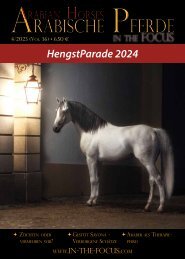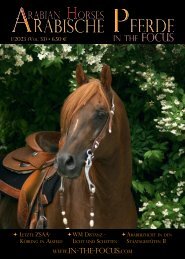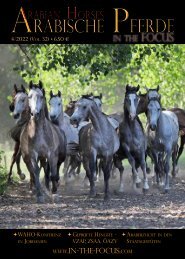Arabische Pferde IN THE FOCUS 4/2020 (Vol. 24) - public
Zeitschrift für Liebhaber und Züchter Arabischer Pferde
Zeitschrift für Liebhaber und Züchter Arabischer Pferde
Erfolgreiche ePaper selbst erstellen
Machen Sie aus Ihren PDF Publikationen ein blätterbares Flipbook mit unserer einzigartigen Google optimierten e-Paper Software.
History of Arabian Horse Breeding in Poland (II)<br />
The Horrors<br />
of War<br />
History<br />
Stud manager Bogdan Ziętarski, here in Arabian attire, together with Carl Raswan went on one of the last expeditions to the Arabian peninsula to<br />
buy horse. They brought four stallions and four mares for the Gumniska Stud of Prince Roman Sanguszko, who holds the lead of the stallion Ahmed.-<br />
Gestütsmanager Bogdan Ziętarski, hier in arabischer Kleidung, unternahm mit Carl Raswan eine der letzten Expeditionen auf die arabische<br />
Halbinsel zum <strong>Pferde</strong>kauf. Sie brachten vier Hengste und vier Stuten für das Gestüt Gumniska des Fürsten Roman Sanguszko, der hier den<br />
Hengst Ahmed hält.<br />
Foto: 1931, Polish National Digital Archives<br />
In our last issue, we described the rise of Polish Arabian breeding in the hands of the noble<br />
families Sanguszko, Dzieduszyki and Branicki, until World War I hit with brutal force. At the<br />
end of the First World War, a mere fifty-six mares and a handful of stallions were all that<br />
remained of a century of Polish Arabian breeding.<br />
Roman Władysław Sanguszko, greatgrandson<br />
of Prince Eustachy Erazm<br />
and nephew of Roman the Younger,<br />
would not give up, even after his uncle had<br />
been stabbed to death by Bolshevik soldiers<br />
at the steps of his family home. Sławuta and<br />
Chrestówka were not to rise from the ashes,<br />
but Gumniska did. In 1918 Poland’s independence<br />
was restored, though too late for the<br />
Arabian horses: A hundred years of Sanguszko<br />
breeding had been reduced to eight brood-<br />
4/<strong>2020</strong> - www.in-the-focus.com<br />
mares and three stallions following the Bolshevik<br />
Revolution. In this post-war period Roman<br />
Władysław Sanguszko began to rebuild<br />
his family’s fabled stud. In late 1930, he sent<br />
his stud manager Bogdan Ziętarski on one<br />
of those desert excursions that had made<br />
Sławuta so great a centre of Arabian breeding<br />
in the nineteenth century. Accompanying<br />
him was Carl Raswan, a German, recognised<br />
internationally as an authority on the Arabian<br />
horse.<br />
67<br />
The last Expedition<br />
Over several months, Ziętarski and Raswan<br />
covered Arabia deserta from Syria to Bahrain,<br />
from Iraq to the Nejd, as well as Egypt<br />
and Turkey. They saw perhaps two thousand<br />
horses (some 1250 of them in Egypt<br />
alone), and crossed tens of thousands of<br />
kilometres. Afterwards, Ziętarski published<br />
an official account of the expedition, which<br />
differed significantly from the letters he<br />
sent to Prince Roman, omitting such details
















